1971 Spanish Grand Prix race report
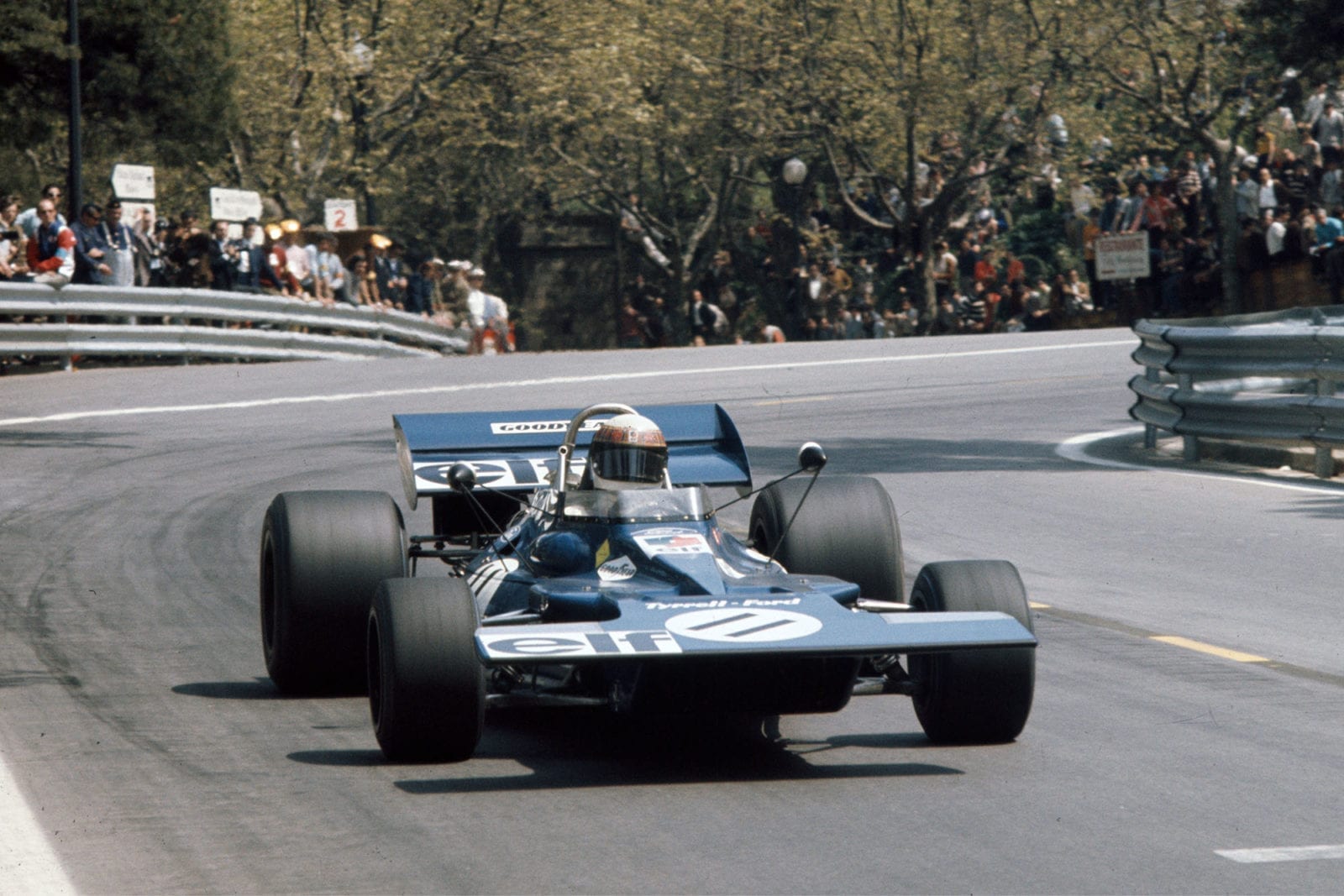
Jackie Stewart took Tyrrell's first victory as both a team and constructor
Motorsport Images
The Tyrrell’s first victory
Barcelona, April 18th.
For the second time in the current Formula One, the Spanish Grand Prix was held on the remarkable circuit in the Montjuich Park in the heart of Barcelona, the first time being in 1969, when front and rear aerofoils were at their greatest height and lots of them fell off, some right in front of officialdom, so that an instant rule was passed which banned high aerofoils and movable ones. Consequently the lap record was considered by some to be an ultimate, they feeling that the new aerofoil rules were stunting progress. That was nonsense, of course, and two years of development and progress in engine-power, brakes, road-holding and handling have more than made up for any advantages that the high aerofoils might have given. The 1969 lap record was left at 1 min. 28.3 sec. by Rindt with a Lotus 49, and practice in 1971 was barely half-way through before anyone who was anyone in Grand Prix racing was way below this figure, and everyone was there to have a go, right from the moment that practice began on the Thursday evening before the race.
As the paddock gate was opened the cars and drivers came out one by one and set off for practice, and it was a sight to enthral any regular racing enthusiast, let alone the thousands of locals who probably had not seen or heard a Grand Prix car engine since 1969. Amon (Matra V12), Andretti (Ferrari flat 12), Stewart (Tyrrell V8), Rodriguez (BRM V12), Regazzoni (Ferrari flat 12), the Lotus 72 cars, the March 711 cars, the Surtees cars, they were all there, and were all ready to go, all that is except Gethin whose McLaren M14A was in the paddock with leaking fuel tanks. The way the numerous 12-cylinder cars moved away up the hill from the pits, with the relatively flat-sounding V8s intermingled with them, was stirring stuff and started the whole meeting off on a keen note, like the first bull into the ring being a real brave one. Some were really ready to go, like Amon with the first of the 1971 Matras, and Stewart with last year’s Tyrrell which he was using as a spare car having a brand-new Tyrrell car all ready for him whenever he wanted it, this being the third car from the Tyrrell team.
At the opposing end of the field were numerous newcomers, who were not only feeling their way along in the Grand Prix scene, but were also discovering the twists and turns, up and downs, humps and bumps of the Montjuich circuit for the first time, and others like Stommelen, who was sitting in his brand-new Surtees for the first time and finding that nothing really fitted him, though the car was basically all right as Surtees had bedded it in at the Easter meeting at OuIton Park. The Lotus team had converted both of their 72 models to the new arrangement of oil tank, single-piece aerofoil and twin oil radiators at the rear, and had built aluminium ducts to scoop air into them, as Ferrari did on his 1970 models and BRM on this year’s models. Fittipaldi was in 72C/R5 and had alternative nose cowlings available, last year’s with the NACA ducts taking air to the front brakes, and the 1971 nose with a smooth top and waisted sides taking cooling air into the inboard brakes from the sides. Wisell was in 72C/R3 with the 1971-type nose. The strong Ferrari trio of Ickx, Andretti and Regazzoni were all in 1970 Ferraris, respectively No. 3, No. 2 and No. 4, and were expecting a 1971 car the following day. Hill had the odd-looking Brabham BT34 with the outrigger radiators, and Schenken had the BT33 he had driven for the team at Brands Hatch. Hulme had the 1971 McLaren and Gethin the 1970 model he drove so well at Oulton Park.
Stewart’s official car for the race was a brand-new Tyrrell, making its first appearance, and he had the original car as a training car, while Cevert was in the rebuilt second car. The BRM team had four cars, two 1971 models and two 1970 models, with Rodriguez in P160/01, Siffert in P160/02 and Ganley in P153/03, with P153/07 as a spare in case anyone did any serious damage to his own car. The STP-March team were out in force with three 711 models, all with the front brakes mounted on the hubs instead of inboard, and all lacking the fancy covers over the side radiators and the engine. Andrea de Adamich had the first car, with an Alfa Romeo V8 engine, Peterson had the second car, with a Cosworth V8 engine, and Soler-Roig had the fourth car built, also with a Cosworth V8, all three being painted STP red, (but not Reflectagto red). The third 711 to be built was being driven by Pescarolo for Frank Williams, and it had been severely modified with stronger front wishbones, strengthening gussets here and there, a stronger rear suspension frame under the gearbox, and hub-mounted front brakes, and was painted in its usual dark blue.
The Matra team had their two 1971 cars, designated MS120B, with Amon in the first one, which has a very similar monocoque to the 1970 model, and Beltoise, back in the fold after having his licence returned, following the unfortunate Buenos Aires crash incident, in the second one. Their numbering follows on from 1970, being 04 and 05, respectively, the second car having smooth, sloping sides to the monocoque instead of the angular, shelf-like layout of the earlier cars. Amon had one of the 1970 cars as a spare, and both the new cars were using the high intake duct that looms over the driver’s head like a bird’s beak. The final team was the Surtees duo, with the owner in TS9/001 and Stommelen in TS9/002. This race should have seen the whole entry carrying their obligatory red rear lights, but for some obscure reason the idea has been postponed until July.
Qualifying
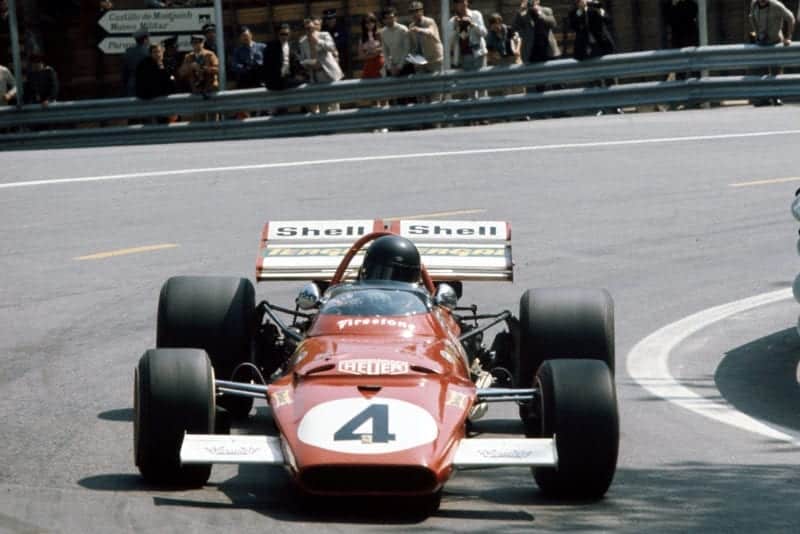
Ickx took pole for Ferrari
Motorsport Images
Practice saw the usual business of some drivers and teams being switched on and others being very switched off, or just lacking in preparation. Surtees and Hulme had hardly begun to practise before their Cosworth engines broke, and Fittipaldi stopped his Lotus 72 out on the circuit with a lack of fuel pressure, and when a mechanic went and got him going again he was then troubled with the brakes not being to his liking. The Montjuich circuit is an extremely hard one and a testing one, very similar in character to Monte Carlo, but amid trees lined with double Armco barriers all the way round, instead of the houses and hotels of the Monegasque circuit. There was plenty of aviating over the brow of the hill after the pits, and a lot of hectic braking and locking of wheels going into the two downhill hairpins and the downhill right-angle bends. The 12-cylinder cars were setting the pace, especially the Ferrari of Ickx, and his Formula Two Montjuich experience was helping, as was Stewart’s, for he had the new Tyrrell among them all the time, and by sheer brilliant driving he had the Tyrrell ahead of them all at the end of the day.
Pescarolo’s Formula Two experience on the circuit was proving invaluable, and he had the Williams March 711 up among the fast runners, but that was his ultimate, for he improved no further, while almost everybody else did in the second evening of practice. Andretti was not being outstanding as he did not feel really at home among the close confines of the Spanish guard rails, being used to a run-off area of loose stuff before the steel barriers on most of the American circuits. All the way round the Montjuich there is little or no opportunity to overdo things, a few inches off line meaning violent contact with solid steel. It was all rather like the old street races of Naples, Bari, Siracusa, Bordeaux, Angouleme, and so on, where minimal error meant a wheel broken in contact with a kerb or brick wall. Andretti did in fact make violent contact with a guard rail after a spin and shattered the left-rear wheel.
All the Firestone users had a new type of tyre available, which was a pure drag-racing “slick” of solid rubber with no tread whatsoever, there merely being a few small holes for measuring rubber depth as on drag-racing tyres, and most drivers were finding them very good, on both front and rear wheels. Late evening practice was all very well, but it meant finishing with the street lights on, and while everyone was packing up, darkness fell.
On Friday the practice session was again in the evening, and the Ferrari team produced a 1971 car for Regazzoni to use experimentally, and Amon started to use his spare Matra but it died on him. The pace was really warming up, and even some of the new boys were approaching the old lap-record, which must have pleased designers of new cars, and development people. The 12-cylinder cars were beginning to dominate things, but always Stewart was driving harder and harder and staying with them, but this time he was relegated to fourth fastest, with Ickx out in front, followed by Amon and Regazzoni, while Rodriguez and Beltoise were just behind the Scot. If it hadn’t been for Stewart, the outlook of the Cosworth brigade would have been distinctly gloomy. HuIme and Surtees had changed their broken engines, and Gethin was having his first practice and driving in a very smooth and relaxed manner, in strong contrast to some of the “new boys” who are supposed to be the future “aces”. A car driven smoothly, with no heroics, is often much faster than it looks, and this was the case with Gethin, for at the end of practice there was only one Cosworth-powered car ahead of him, and that was Stewart’s Tyrrell, which was no mean achievement in one practice session. As the practice drew to a close there was every sign that someone was going to break 1 min. 26 sec., and it was Ickx who did, with 1 min. 25.9 sec. Right behind him were Regazzoni, Amon, Stewart, Rodriguez and Beltoise, seven-tenths of a second covering them all. Regazzoni did some running with the new car, but it was clear that the team were going to rely on the 1970 cars.
Everything was working up nicely to a final fling on Saturday evening, when there would obviously be a bunch of cars below 1 min. 26 sec., and even the slowest ones would be approaching the old lap record of 1 min. 28.3 sec., but the weather gods had other ideas. During the Formula Three race which preceded the final practice, the rain came down in a big way, and thunder and lightning swept across the skies. The Formula Three race became a farce, and though the storm passed, the roads never dried up and the final Grand Prix practice was a dead loss, especially for some like Surtees, who had finally got his new engine to run reasonably well and got his gear ratios right. Stewart did enough to weigh up the wet conditions and was fastest with 1 min. 37.0 sec., just ahead of Hulme and Surtees, and the first 12-cylinder car was Beltoise’s Matra in fourth place.
Race
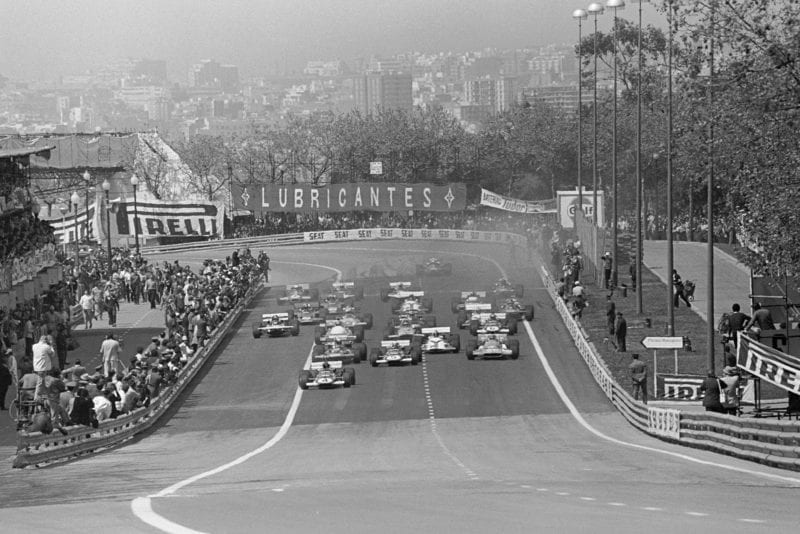
The race gets underway
Motorsport Images
The race was due to start at 11.30 a.m. on Sunday morning, by which time the skies were very clear and the sun was blazing down on the enormous crowd that lined the circuit. After some confusion and chaos in the marshalling area the cars were wheeled out, and along with the drivers were presented to the grandstands of honour, before being sent away one at a time on a warm-up lap. Ickx used the opportunity to try his Ferrari as if in the race, and he could not have breasted the hill after the start any quicker had he been racing. The twenty-two starters lined up on the grid, there only being two Cosworth V8-powered cars in the first three rows, Stewart’s Tyrrell in the second row and Gethin’s McLaren in the third row, ready for the start of the 75-lap race, a long and gruelling 284 kilometres round the difficult and exacting 3.79 kilometre circuit, with little or no room for error, under a blazing sun.
Up and over the hill the whole pack roared, with Stewart hard on the heels of the Ferraris of Ickx and Regazzoni, the young Belgian boy obviously being out to win. As they all crowded up at the first hairpin the leaders swept round, but in the mid-field someone chopped across the front of Hill’s Brabham and clouted a front wheel so hard it took the steering wheel out of his hands and he found himself almost stationary on the apex of the hairpin. This caused a chain-reaction among the tail-enders, and Surtees, Stommelen, Soler-Roig and one or two others were forced to stop completely, while Schenken and Wisell went round the outside. This little fracas deranged the steering on Hill’s Brabham, and Surtees crumpled a nose tin. Hill was forced to give up, Surtees later stopped and changed his crumpled cowling for the one off Stommelen’s car, as the second Surtees would not run properly due to bits of metal finding their way through all the filters and jamming the fuel pressure relief valve open, so the German driver had retired.
Siffert came in to retire with damaged gear-change linkage on the gearbox, thought to be due to being involved with someone on the first hairpin nonsense. Meanwhile, Ickx and Stewart were soon out on their own and there began one of the better Grand Prix races. The old lap-record went almost instantly, and Stewart was hounding Ickx mercilessly and got by on lap six, but his lead was neglible. For the whole race these two battled it out, lapping faster and faster, and Stewart was on the limit all the time, with Ickx driving equally as hard and keeping Stewart right on his toes. Diving, twisting and turning round the park these two kept at it in a masterly display of driving, leaving all the opposition behind, and lapping all the slower cars, some of them twice. In and out of the traffic Stewart tried all he knew to get rid of the Ferrari, but there was no hope, Ickx kept pressing all the time, but towards half-distance Stewart’s stamina began to tell, and little by little he opened up a gap and it got to as much as nine seconds, but then Ickx seemed to get a second wind, and as the fuel load was going down the Ferrari was handling better and better.
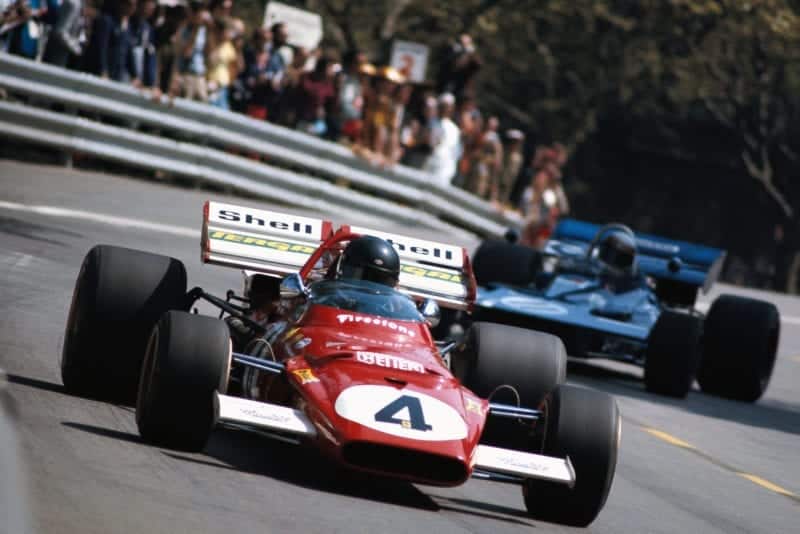
Ickx leads Stewart
Motorsport Images
The gap now began to close and bit by bit Ickx was closing it, all the while the lap-record being broken time and time again by both drivers. There was no relaxation for Stewart, he was driving at his absolute best, on the limit of everything all the time, and the brand-new Tyrrell was holding together. Closer and closer the red Ferrari got, until Ickx had the dark blue Tyrrell in sight down the twisty hill. As the Ferrari landed after the jump at the top of the hill past the pits, Ickx got a broadside view of the Tyrrell driving into the left-hand hairpin. They were both lapping faster than ever they had gone in practice, running consistently around 1 min. 25.5 sec., and on lap 69 Ickx recorded 1 min. 25.1 sec., an all-time record lap. In the closing laps they blasted past some back markers, but Stewart made no mistakes, and he finished the 75th lap going as hard as he has ever had to drive, with the red Ferrari in hot pursuit. Both cars had been driven to their absolute limit and both had responded perfectly, neither one missing a beat or failing in any way.
It had been a memorable battle which kept everyone on their toes the whole time, and had completely overshadowed the rest of the runners, some of whom were doing good things, while some were best overlooked. Regazzoni’s initial spurt fizzled out when the low-pressure fuel pump down by the gearbox cracked and let the fuel pressure fluctuate, with a result that the engine ran on a weak mixture and began to seize up, so it was pulled out of the race before it wrecked itself completely. Andretti got into a good three-cornered battle with Rodriguez and Hulme, battling it out for fourth place behind Amon’s Matra. This went on until lap 43, when Andretti had to stop with a small fire going on at the back of the car. His fuel pump had also cracked, and sparks from the pump had set fire to the leaking fuel, but luckily with the power on the petrol was sucked away from the leak and the fire went out, but on the over-run into corners it would leak out and ignite again.
Hulme could see this happening and finally managed to alert Andretti’s attention to the hazard, and he stopped at the pits. Another pump was fitted and he went off again, but as with Regazzoni’s car, the weak mixture had been playing havoc with the inside of the engine, and as it was about to break Andretti stopped, with yet another fire started from the replacement pump. A well-meaning fireman covered everything with foam, including the driver, and that was the end of the American’s race.
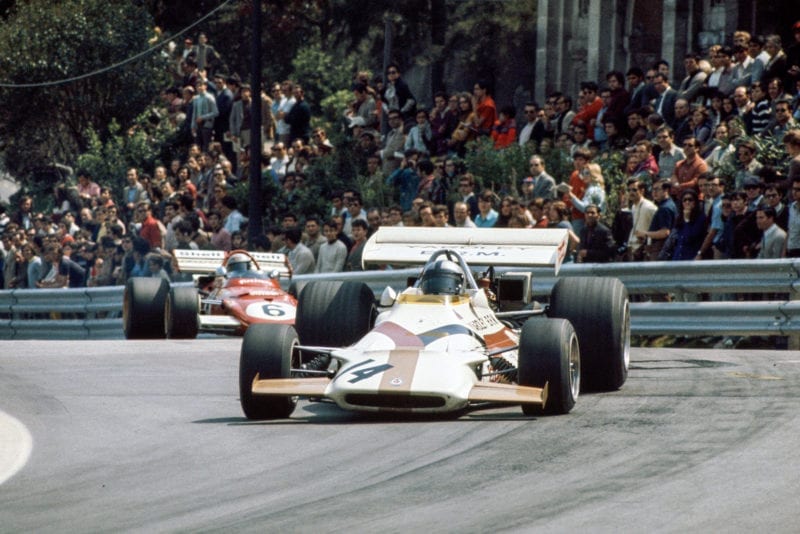
Rodriguez heads Andretti
Motorsport Images
Rodriguez ran right through in a steady fourth place, with Hulme fifth after a very satisfactory afternoon’s drive, except that he didn’t win. Amon had taken third place from Regazzoni on the third lap, and he held that position throughout the race, never looking like losing it, nor improving on it, the Matra running strongly apart from a hesitant pick-up from the slow corners. Gethin profited from his good starting position but gradually dropped back, and was relegated to a steady eighth place behind Beltoise and Cevert. The Matra driver went well, but Stewart’s young team-mate drove even better, and gradually closed on Beltoise until he got to the point of making a bid to snatch sixth place. Just at that moment, on lap 64, Stewart appeared behind him, at the height of his battle with lckx, so dutifully Cevert got out of the way to let Stewart by and lost all hope of taking sixth place from Beltoise.
As at the Race of Champions, Schenken in a Brabham, and Ganley in a BRM were remarkably evenly matched and ran in close company throughout the race, even recording identical fastest laps at 1 min. 28.9 sec. This time Schenken led all the way, and made no mistake at the end, so that they finished ninth and tenth. The Lotus pair were never in the picture, Fittipaldi having no faith in his brakes, especially after the warning light had come on, indicating low fluid level, but a stop at the pits made no improvement after bleeding them and adding more fluid. The car continued to swoop about under heavy braking, and after the race a break was found in part of the rear suspension cross-member assembly.
Wisell was equally unimpressive, suffering most of the time with a recalcitrant gear-change, due possibly to it being out of correct adjustment after repositioning the gear lever, when he decided in practice to adopt a different driving position. Pescarolo’s apparent burst of speed in the first practice did not develop into anything better, and in the race his engine was never on full song. In the opening stages he was in twelfth place and just about hanging on to the mid-field bunch, but could not have been too pleased when he was lapped first by Beltoise on lap 47, and then by Cevert, on lap 49. Shortly after that the front mounting of the rear aerofoil broke, and that was sufficient to call it a day with the dark blue March. The three red March 711 cars ended the day spread round the circuit, Peterson’s engine dying from electrical trouble quite early in the race, when he was just ahead of Pescarolo, while the Alfa Romeo-powered March wrecked its final drive unit and Soler-Roig was in twelfth place when a fuel pipe broke and brought him to rest.
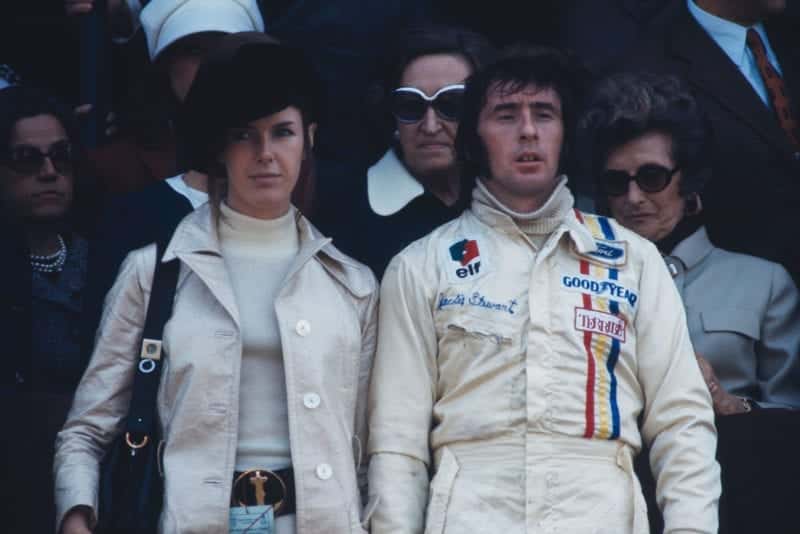
Jackie Stewart stands on the podium after winning his first race of the season
Motorsport Images
For the first two cars it had been a brilliant race, hard-fought and won by sheer driving ability on Stewart’s part, for the other twenty cars it had either been steady and dull with unsatisfactory results, for everyone would like to win or be an honourable second, or it had been disastrous and a miserable failure. For the huge and excitable crowd it had been a day to remember, with sights and sound they may not see again until 1973.—D. S. J.
